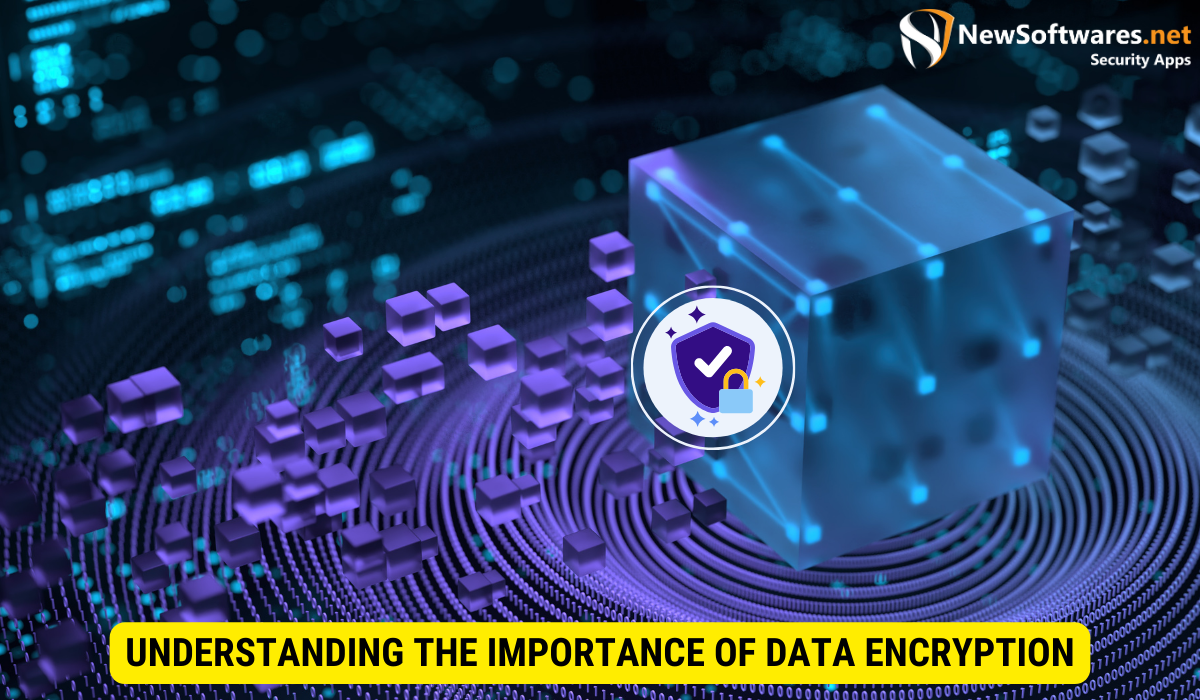Data encryption using Python OS means utilizing Python’s extensive cryptographic libraries to encode sensitive information, ensuring enhanced security and controlled access.
Data security is an essential concern for individuals and organizations alike. With the increasing dependence on digital data and the increasing risk of cyber attacks, it has become crucial to protect sensitive information. One effective method to achieve this is through data encryption. Together, we will explore the importance of data encryption and how Python OS can create encrypted data files for enhanced access and security.
Understanding the Importance of Data Encryption

Data encryption means encoding data so that only authorized individuals can access and decrypt it. Encryption acts as a barrier, preventing unauthorized parties from accessing sensitive information. Encrypting data will remain unintelligible without the decryption password, even if it falls into the wrong hands. This enhances data security and helps maintain confidentiality.
Furthermore, data encryption ensures the integrity of information. Any tampering or unauthorized modifications to encrypted data become immediately apparent, as decryption would fail or result in distorted content. This protects the integrity and authenticity of the data, making it a valuable tool in minimizing the risk associated with data breaches and tampering.
The Role of Encryption in Data Security
Encryption serves a crucial role in data security. It provides a means to protect sensitive information stored on digital devices or transmitted over networks. Whether it’s personal financial data, private communications, or corporate secrets, encryption safeguards valuable information from unauthorized access.
Moreover, encryption helps adhere to privacy regulations and data protection laws. Various industries, including finance, healthcare, and e-commerce, have compliance requirements that dictate the encryption of sensitive data. Non-compliance can direct to severe legal consequences, such as fines and reputational damage.
Why Python OS for Data Encryption?
Python OS (Operating System) is a versatile & powerful programming language extensively used for its simplicity and readability. It provides an extensive library of cryptographic functions and modules, making it an excellent choice for data encryption.
Python OS’s cryptographic libraries, such as “cryptography,” offer a range of encryption algorithms, including Advanced Encryption Standard (AES), Triple Data Encryption Standard (3DES), and Rivest Cipher
Algorithm (RC4)
These algorithms are implemented securely and efficiently, ensuring strong encryption for data files.Additionally, Python OS’s extensive community support and documentation make it easier for developers and administrators to implement encryption within their projects. The availability of third-party libraries and frameworks further enhances the functionalities and flexibility of Python OS for data encryption.
Basics of Python OS
Before creating encrypted data files, let’s provide an overview of Python OS. Python OS is an open-source programming language known for its simplicity and readability. It supports multiple programming paradigms including procedural, object-oriented and functional programming.
An Overview of Python OS
Guido van Rossum created Python OS, and first released in 1991. Its design philosophy emphasizes code readability and simplicity, making it an perfect choice for beginners and experienced developers. Python OS’s syntax uses indentation and a clear, concise style, which aids in developing and maintaining code.
The language’s versatility allows it to be used in various domains, including web development, software engineering, data analysis, machine learning, and data security through encryption.
Key Features of Python OS
Python OS boasts a range of features that contribute to its popularity. Here are some key features:
- Readable and expressive syntax: Python OS’s syntax is designed to be clear, readable, and expressive. This promotes code maintainability and collaboration.
- Broad library support: Python OS’s extensive standard library and third-party libraries provide various functionalities for diverse use cases.
- Platform independence: Python OS is available on various operating systems, ensuring portability and flexibility.
- Integration capabilities: Python OS can be easily integrated with other programming languages, allowing developers to leverage existing code and libraries.
- Interpretive nature: Python OS is an interpreted language that does not require compilation. This makes it highly accessible and allows for rapid development and debugging.
Steps to Create Encrypted Data Files in Python OS
Now that we understand Python OS and its key features let’s explore the steps in creating encrypted data files.
Preparing Your System for Encryption
The first step is to ensure that your system has the necessary prerequisites for encryption. This includes installing Python OS and the required cryptographic libraries. You can use package managers such as pip or conda to install the necessary dependencies.
Once the dependencies are installed, setting up a protected environment for storing encryption keys and other sensitive data is essential. This can be done by creating a separate folder with restricted access permissions.
Writing the Encryption Code
With the system prepared, it’s time to write the encryption code using Python OS. Start by importing the necessary cryptographic libraries, such as “cryptography.”
Next, define the encryption algorithm and the key size. Depending on your requirements, choose an appropriate encryption algorithm and key size.
You can write the encryption code once the algorithm and key size are set. This typically involves reading the data to be encrypted, generating a random encryption key, encrypting the data using the chosen algorithm and key, and finally writing the encrypted data to a file.
Testing the Encrypted Data Files
After creating the encrypted data files, it is crucial to test their accessibility and security. Implement test cases to verify that only authorized individuals can decrypt and access the data. This ensures the encryption process has been successfully implemented and the data remains protected.
Regularly perform thorough testing, including negative test cases, to identify any vulnerabilities or weaknesses in the encryption implementation and address them promptly.
Enhancing Access and Security with Python OS
Python OS offers various features and mechanisms to enhance access control and security when working with encrypted data files.
Access Control Mechanisms in Python OS
Python OS provides built-in mechanisms for managing access control to files and directories. Operating system functions and libraries enable restricting read, write, and execute privileges to authorized users or groups.
You can create robust access policies for encrypted data files by leveraging Python OS’s access control mechanisms. Only authorized entities can access the encrypted data, enhancing overall security.
Security Features of Python OS
Python OS provides several security features that can be utilized while working with encrypted data. Some of these features include secure key storage, secure random number generation, and secure communication protocols.
The “cryptography” library in Python OS offers secure methods for generating random numbers, which is essential for encryption key generation. Additionally, Python OS provides secure ways to store encryption keys, such as utilizing secure key management systems or appropriate encryption key storage practices.
Furthermore, Python OS supports secure communication protocols, such as Transport Layer Security (TLS) and Secure Shell (SSH), which can be valuable when transferring or transmitting encrypted data files.
Troubleshooting Common Issues

You might encounter certain common issues while creating encrypted data files with Python OS. Here are a few troubleshooting tips:
Dealing with Encryption Errors
If you encounter encryption errors, check that the encryption algorithm and key size are compatible with the used cryptographic library. Ensuring that the decryption code matches the encryption algorithm and parameters is also essential.
Moreover, verify that the encrypted data is in the correct format and that any special characters or encoding requirements are handled appropriately.
Resolving Access and Security Issues
If you experience access or security issues with encrypted data files, double-check access control permissions for the files and directories involved. Validate that the correct user or group has the necessary privileges to access the files.
In addition, evaluate the security measures implemented for protecting encryption keys. They must adhere to best practices and industry standards to prevent unauthorized access.
Key Takeaways
- Data encryption plays a vital role in data security, providing both confidentiality and integrity.
- Python OS offers a versatile and powerful platform for creating encrypted data files.
- Python OS’s extensive library support and community make it an excellent choice for implementing data encryption.
- Preparing your system, writing the encryption code, and testing the encrypted data files are essential steps in the process.
- Python OS provides several access control and security features that can enhance data security.
FAQs
Q1. Why is data encryption important?
Data encryption is necessary for shielding sensitive information from unauthorized access and maintaining data integrity. It helps adhere to privacy regulations and reduces the risks associated with data breaches.
Q2. How does Python OS aid in creating encrypted data files?
Python OS provides a range of cryptographic libraries and functions that enable easy implementation of data encryption. Its simplicity, readability, and extensive community support make it an ideal choice for creating encrypted data files.
Q3. What encryption algorithms does Python OS support?
Python OS supports various encryption algorithms, including Advanced Encryption Standard (AES), Triple Data Encryption Standard (3DES), and Rivest Cipher Algorithm (RC4). These algorithms offer secure and efficient encryption for data files.
Q4. How can Python OS enhance access control for encrypted data files?
Python OS provides built-in mechanisms for managing access control to files and directories. By leveraging these mechanisms, access policies can be implemented to make certain that only authorized entities can access encrypted data files.
Q5. What should I do if encryption errors occur?
If encryption errors occur, ensure compatibility between the encryption algorithm and key size with the cryptographic library used. Validate that the encryption and decryption code match and correctly handle data format and encoding requirements.
Conclusion
Data security is dominant in today’s digital age, and encryption is reliable for protecting sensitive information. Python OS’s versatility and extensive library support make it an excellent choice for creating encrypted data files. By following the steps outlined, you can implement robust data encryption and enhance access control and security. Secure your data with Python OS encryption and safeguard your valuable information.
